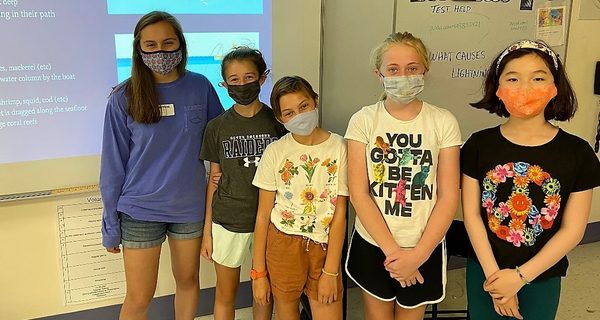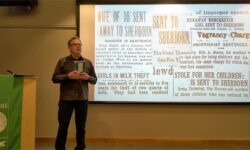Katherine Whittle explained that a large part of what drove her to create the Youth Environmental Stewardship Program is the belief that younger kids both look up to and relate better with older students.
By James Kinneen
Hometown Weekly Reporter
On June 8 and 9, the sixth graders of Dover-Sherborn Regional Middle School got a lesson on fisheries and the unwanted critters they tend to accidentally kill as bycatch.
The students heard from a climate Jedi and Youth Leader in Climate Justice with the Massachusetts Audubon Society, fresh off winning “Best Education Plan” victory at the Massachusetts Youth Audubon Climate Showcase. They also heard from the chair of the Education Subcommittee of Dover’s Sustainability Task Force, as well as the founder of an initiative called the Youth Environmental Stewardship Program, which will see Dover-Sherborn’s upperclassmen teach younger students about environmental issues.
How’d they fit all these people into one room?
It wasn’t especially difficult, since they’re all the same person.
Recent Dover-Sherborn High School graduate Katherine Whittle is a member of the “climate Jedis” ("Jedi" is an acronym for justice, equity, diversity and inclusion): a specific group of Mass Audobon’s Youth Leaders in Climate Justice. After evaluating the assets and vulnerabilities of different communities in terms of climate resistance, the group identified a disparity in environmental education, and decided to create a curriculum about a lesser-known environmental issue. The idea is that the Google Slides-based curriculum will be available for free on the Mass Audubon website, so that anyone can take it and teach a class on the subject.
“Because there’s a disparity in environmental education across the state, these will be publicized,” she explained. “It can be taught by another kid elsewhere or by a teacher, kind of like how teachers share curriculum so they don’t’ have to keep reinventing the wheel. We’ve done so much research on whatever issue we chose to do, that we’ve kind of become the experts. So if it’s not an area the teacher knows so much about, they have the opportunity to take up the curriculum and learn about it and then spread the knowledge out to their classes.”

Noting her love of the ocean, Whittle chose to create a curriculum on fisheries, with special attention paid to the issue of bycatch, the unwanted marine creatures fisherman inadvertently haul in while trying to catch their targeted species. Once the curriculum was completed in May, Whittle reached out to her middle school science teacher, Mr. Thompson, to see if she might present her work, as it would be “a good opportunity for me to test the effectiveness and flow of my curriculum while also essentially giving me and the sixth graders a chance to learn from each other.”
Thompson not only said yes, but surprised Whittle by bringing in another teacher’s class. Over the course of two days, Whittle had presented her hour-and-a-half presentation over five blocks during two days of teaching, meaning all 160 middle school students would see it. While Whittle wanted to make it clear she was not using the students as guinea pigs, and that the opportunity to teach the students was great for both her and them, she did learn some things about her curriculum that she needed to change.
“I definitely relied on a bit of background knowledge for certain things, so I have to input that in the presenter notes. We also didn’t quite have enough time for them to design their own bycatch-reducing fishing gear, which would give them an opportunity to come up and present, like fifteen minutes in small groups, how to scare away non-target groups or allow them to get out of nets. We had to file everyone into the room, which cut down on time.”
While Whittle came away with some improvements to make, she believes the students thoroughly absorbed the magnitude of the problem, noting that her first Kahoot! game (Kahoot! is a game-based learning platform) shocked kids by telling them how many loggerhead and leatherback sea turtles die each year as a result of bycatch: 250,000. Other of the more striking slides compared the length of longlines (basically giant lines of baited fish hooks) to the Boston Marathon route (they're about equal), showed a turtle with a hook in its mouth, and referenced a few "Finding Dory" scenes to talk about the impact of ghost gear (that is, discarded fishing nets or other tools). Within the presentation, students also learned about how they and their families could cut back on this bycatch - for example, by eating soy-based "tuna" or seafood that is lower on the food chain.
With that presentation going so well, Whittle is trying to create a program where older students will teach younger children environmental issues. While the start of that program may come next fall, Whittle’s curriculum is expected to be done by the end of summer.


























